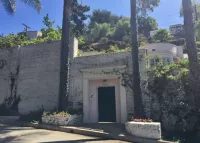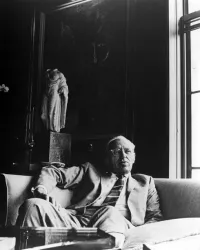Share what you know,
and discover more.
Share what you know,
and discover more.
Mar 04, 2022

-

- Charmaine Bantugan
George Cukor Residence
Designed by prolific architect Roland E. Coate, legendary director George Cukor's residence in the Hollywood Hills provided a luxurious backdrop to the director's vibrant social life. Born in New York, Cukor (1899-1983) rose to be one of the most successful gay directors in the 1930s, 1940s, and 1950s. He prospered despite working under the auspices of the Production Code Administration (PCA), which required filmmakers to submit their work for approval to ensure that it aligned with traditional Christian values. His career spanned more than fifty years, with a body of work including such classics as The Philadelphia Story, My Fair Lady, Let's Make Love, Camille, and Little Women. At the height of his career, Cukor's home served as an vital social center in Hollywood's gay community. He hired former film actor William "Billy" Haines as his interior designer, who filled the home with elegant decor and dozens of photographs of Cukor's Hollywood friends. Haines himself had turned to decorating after losing his contract with MGM due to his refusal to deny rumors about his sexuality. SIGNIFICANCE: Amid the rise of conservatism in American politics and culture, Hollywood transitioned from a place of relative acceptance of LGBTQ individuals to one where LGBTQ movie stars (more so than any other group in the film industry) feared for their jobs. As a result, Cukor made it a point to hire LGBTQ actors in the films he directed. Because of this conservative climate in postwar Hollywood, Cukor lived in what many historians call a "celluloid closet," where his sexual identity was an open secret but could never be discussed or acknowledged in the workplace. This is in direct contrast to Cukor's home life, where he surrounded himself with close friends and was famous for his parties. By the mid-1930s, he was considered to be the unofficial "head" of Hollywood's gay subculture. Photo by Laura Dominguez/L.A. Conservancy
George Cukor Residence
Designed by prolific architect Roland E. Coate, legendary director George Cukor's residence in the Hollywood Hills provided a luxurious backdrop to the director's vibrant social life. Born in New York, Cukor (1899-1983) rose to be one of the most successful gay directors in the 1930s, 1940s, and 1950s. He prospered despite working under the auspices of the Production Code Administration (PCA), which required filmmakers to submit their work for approval to ensure that it aligned with traditional Christian values. His career spanned more than fifty years, with a body of work including such classics as The Philadelphia Story, My Fair Lady, Let's Make Love, Camille, and Little Women. At the height of his career, Cukor's home served as an vital social center in Hollywood's gay community. He hired former film actor William "Billy" Haines as his interior designer, who filled the home with elegant decor and dozens of photographs of Cukor's Hollywood friends. Haines himself had turned to decorating after losing his contract with MGM due to his refusal to deny rumors about his sexuality. SIGNIFICANCE: Amid the rise of conservatism in American politics and culture, Hollywood transitioned from a place of relative acceptance of LGBTQ individuals to one where LGBTQ movie stars (more so than any other group in the film industry) feared for their jobs. As a result, Cukor made it a point to hire LGBTQ actors in the films he directed. Because of this conservative climate in postwar Hollywood, Cukor lived in what many historians call a "celluloid closet," where his sexual identity was an open secret but could never be discussed or acknowledged in the workplace. This is in direct contrast to Cukor's home life, where he surrounded himself with close friends and was famous for his parties. By the mid-1930s, he was considered to be the unofficial "head" of Hollywood's gay subculture. Photo by Laura Dominguez/L.A. Conservancy
Mar 04, 2022
George Cukor Residence
Designed by prolific architect Roland E. Coate, legendary director George Cukor's residence in the Hollywood Hills provided a luxurious backdrop to the director's vibrant social life.Born in New York, Cukor (1899-1983) rose to be one of the most successful gay directors in the 1930s, 1940s, and 1950s. He prospered despite working under the auspices of the Production Code Administration (PCA), which required filmmakers to submit their work for approval to ensure that it aligned with traditional Christian values.
His career spanned more than fifty years, with a body of work including such classics as The Philadelphia Story, My Fair Lady, Let's Make Love, Camille, and Little Women.
At the height of his career, Cukor's home served as an vital social center in Hollywood's gay community. He hired former film actor William "Billy" Haines as his interior designer, who filled the home with elegant decor and dozens of photographs of Cukor's Hollywood friends.
Haines himself had turned to decorating after losing his contract with MGM due to his refusal to deny rumors about his sexuality.
SIGNIFICANCE:
Amid the rise of conservatism in American politics and culture, Hollywood transitioned from a place of relative acceptance of LGBTQ individuals to one where LGBTQ movie stars (more so than any other group in the film industry) feared for their jobs. As a result, Cukor made it a point to hire LGBTQ actors in the films he directed.
Because of this conservative climate in postwar Hollywood, Cukor lived in what many historians call a "celluloid closet," where his sexual identity was an open secret but could never be discussed or acknowledged in the workplace.
This is in direct contrast to Cukor's home life, where he surrounded himself with close friends and was famous for his parties. By the mid-1930s, he was considered to be the unofficial "head" of Hollywood's gay subculture.
Photo by Laura Dominguez/L.A. Conservancy
Posted Date
Mar 03, 2022
Historical Record Date
Mar 04, 2022
Source Name
Los Angeles Conservancy
Delete Story
Are you sure you want to delete this story?











